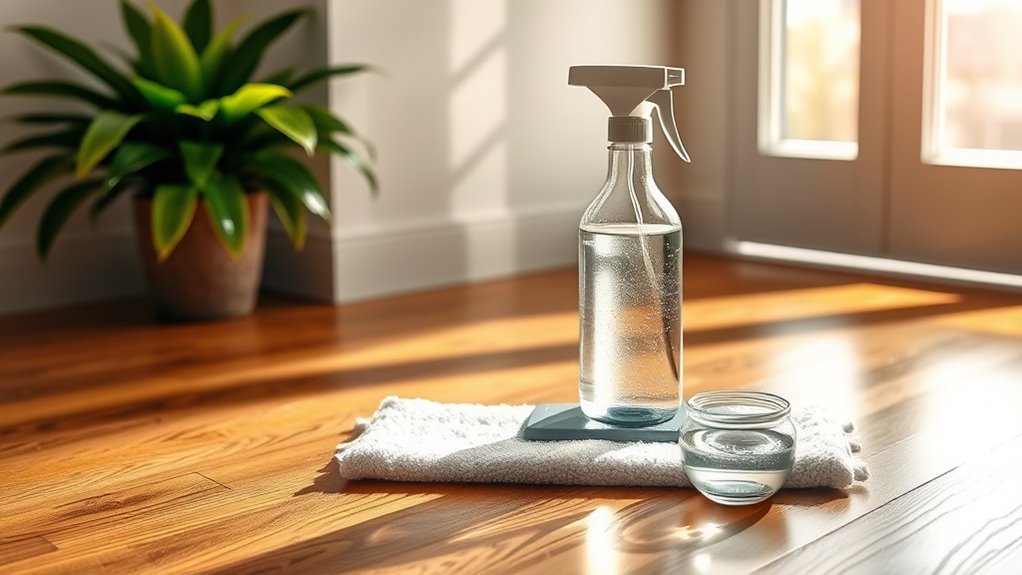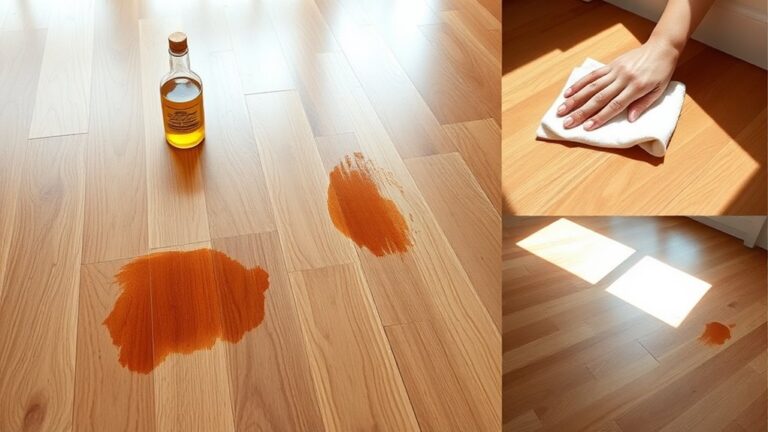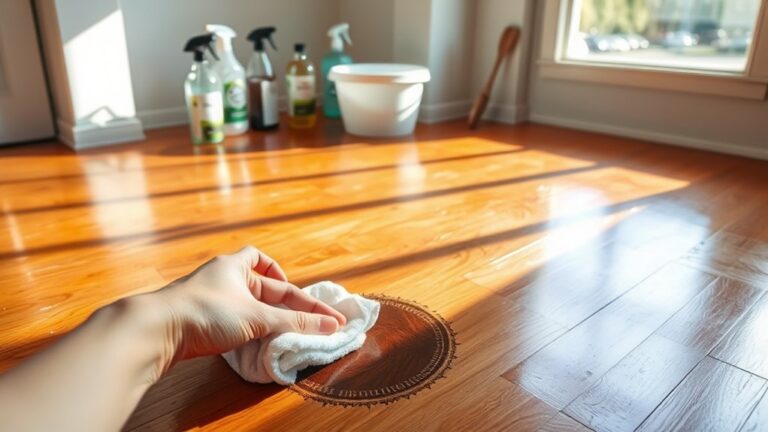You can safely clean wood floors with white vinegar diluted in warm water—about 1/4 cup vinegar per gallon—to avoid damaging the finish. Use a damp, well-wrung mop to prevent excess moisture, which can cause warping. Test the solution on a small hidden spot first, and avoid daily cleaning to protect your floors. With proper preparation and care, vinegar makes a natural, effective option. Keep exploring for tips on preparation, application, and alternatives.
Understanding Why Vinegar Is Effective for Wood Floor Cleaning
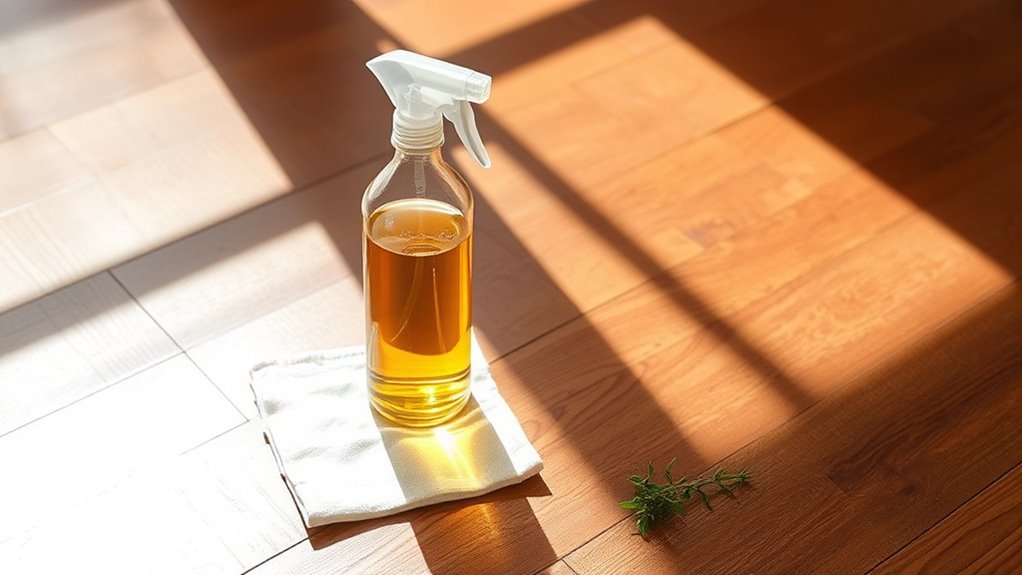
Although vinegar is a common household item, you might not realize how effective it is for cleaning wood floors. Vinegar benefits come from its natural acidity, which breaks down dirt, grime, and grease without harsh chemicals. This makes it a powerful tool for natural cleaning that respects your floor’s finish while eliminating buildup. Using vinegar allows you to maintain your wood floors’ beauty and integrity, avoiding damage caused by synthetic cleaners. It also helps neutralize odors, leaving your space fresh. By choosing vinegar, you embrace a safe, eco-friendly option that supports your desire for freedom from toxic substances. Understanding vinegar’s cleaning power lets you confidently keep your wood floors spotless while protecting your home and health.
Choosing the Right Type of Vinegar for Your Floors
When selecting vinegar for cleaning your wood floors, it’s important to choose the right type to avoid damaging the finish. White vinegar is the best choice because it’s clear, inexpensive, and has a consistent acidity level. Apple cider vinegar might seem natural, but its color and stronger scent can stain or leave residue on your floors. Here’s a quick comparison:
| Vinegar Type | Beste gebruik |
|---|---|
| Witte azijn | Safe for all sealed wood floors |
| Apple Cider | Avoid—it can stain and smell |
| Malt Vinegar | Not recommended for wood |
Sticking to white vinegar guarantees you protect your floors while enjoying a natural, effective clean. Avoid colored vinegars to keep your wood looking fresh and free from unwanted marks.
Dilution Ratios: How to Mix Vinegar and Water Safely
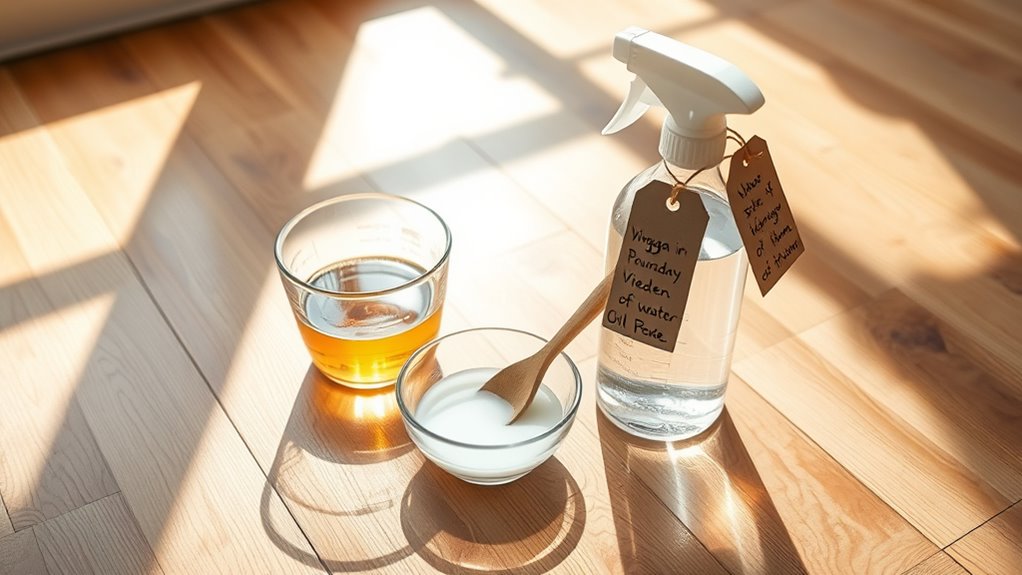
Now that you know white vinegar is the safest choice for your wood floors, the next step is understanding how to mix it properly with water. Getting the vinegar concentration right is essential to avoid damage while maintaining cleaning power. Consider these guidelines:
- Use a 1:10 ratio—one part white vinegar to ten parts warm water—for routine cleaning. This mild concentration protects the finish during regular cleaning frequency.
- For stubborn spots, increase to a 1:5 ratio, but don’t exceed this to prevent wood damage.
- Always test your mixture on a small, hidden area before full application to verify no adverse effects.
Preparing Your Wood Floor Before Cleaning
Before applying any vinegar solution, you should thoroughly prepare your wood vloer to secure effective cleaning and prevent damage. Start by removing all furniture to expose the entire floor surface. This step not only allows you to clean every inch evenly but also prevents vinegar from contacting your furniture, which might cause harm. Next, sweep or vacuum the floor to clear away dust, dirt, and debris that could scratch the wood during cleaning. Pay close attention to corners and edges where dirt accumulates. Finally, check the floor surface for any damage, such as cracks or worn finishes, since vinegar can exacerbate these issues. Proper preparation guarantees your wood floor is ready to receive the vinegar solution safely, giving you freedom to clean effectively without risking harm.
Tools and Materials Needed for Vinegar Cleaning
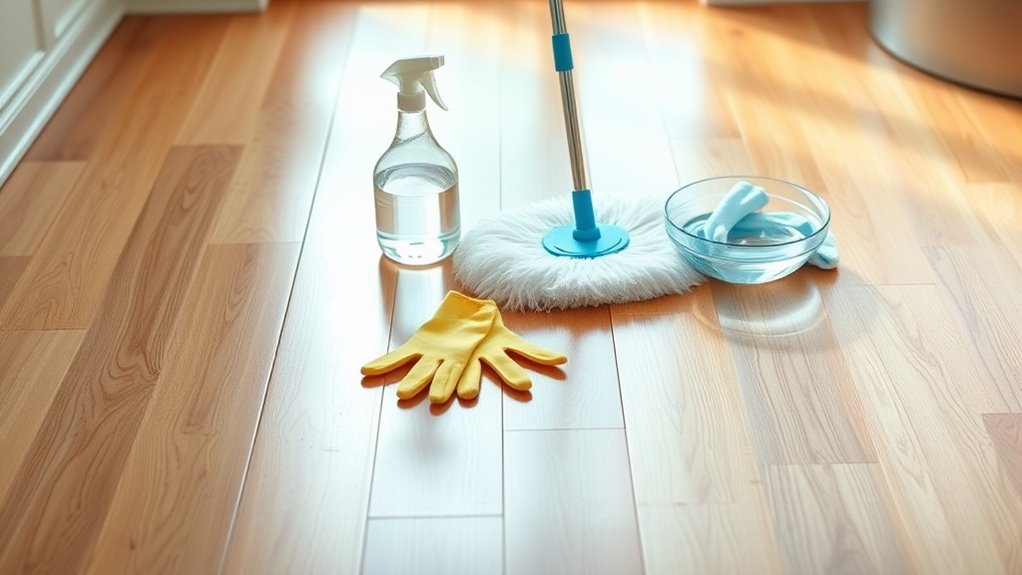
To clean your wood floors with vinegar, you’ll need a few essential supplies like white vinegar, water, a bucket, and a mop or microfiber cloth. Preparing the right vinegar solution is key to avoiding damage, so mixing it in the correct ratio matters. Don’t forget protective gloves and tools to safely and effectively clean without harming your hands or floors.
Essentiële schoonmaakbenodigdheden
Gathering the right tools and materials is essential for effectively cleaning wood floors with vinegar. Choosing eco friendly cleaners helps protect your floor’s finish while supporting hardwood maintenance. You’ll want supplies that make the process efficient and safe.
Here are the essentials you’ll need:
- Microfiber mop or soft cloth – These prevent scratches and pick up dirt without harsh abrasion.
- Spray bottle – Perfect for applying the vinegar solution evenly without soaking the wood.
- Bucket – Useful for mixing your cleaning solution and rinsing your mop if needed.
With these tools, you’ll maintain your hardwood’s natural beauty and enjoy a clean, chemical-free floor. This setup lets you clean confidently, preserving freedom from damaging products while embracing simple, effective care.
Vinegar Solution Preparation
Two key ingredients you’ll need for your vinegar cleaning solution are distilled white vinegar and water, combined in the right ratio to avoid damaging your wood floors. Getting the cleaning ratios right is essential for solution effectiveness, guaranteeing your floors stay protected while sparkling clean. Typically, a mixture of one part vinegar to ten parts water works best.
| Item | Doel |
|---|---|
| Distilled White Vinegar | Disinfects and removes grime |
| Water | Dilutes vinegar to safe strength |
| Measuring Cup | Guarantees accurate cleaning ratios |
| Spray Bottle | Applies solution evenly |
Use these tools and materials to prepare a balanced solution that safely cleans without harming your floor’s finish or integrity.
Protective Gear and Tools
Every cleaning session demands specific protective gear and tools to guarantee your safety and the best results. When cleaning wood floors with vinegar, you’ll need to equip yourself properly to avoid skin irritation and protect your eyes from splashes.
- Protective gloves – These shield your hands from the acidity of vinegar, preventing dryness and irritation.
- Safety goggles – Essential to protect your eyes from accidental splashes, especially when mixing or applying the solution.
- Microfiber mop or soft cloth – Use these to gently clean the floor without damaging the wood’s finish.
Having these tools and gear on hand ensures you clean effectively while maintaining your freedom to enjoy a safe, streak-free wood floor.
Step-By-Step Guide to Mopping Wood Floors With Vinegar
Start by mixing one cup of vinegar with a gallon of warm water to create an effective, natural cleaning solution. Next, dip your mop into the mixture and wring it out thoroughly to avoid excess moisture—this is key in wood floor maintenance. Begin mopping in small sections, moving with the grain of the wood to guarantee even cleaning. Rinse the mop frequently to prevent spreading dirt around and maintain cleaning efficiency. After mopping, allow the floor to air dry or use a dry microfiber cloth to speed drying and avoid streaks. These cleaning techniques not only keep your floors spotless but also preserve their natural beauty and longevity, giving you freedom from harsh chemicals while maintaining a healthy home environment.
Precautions to Prevent Damage to Wood Finishes
Before you start cleaning, always test the vinegar solution on a small, hidden area to guarantee it won’t harm your wood finish. Make sure to use a properly diluted vinegar mix to avoid any harsh effects. Also, avoid using too much water, as excess moisture can damage the wood over time.
Test Vinegar Solution First
Although vinegar is a natural cleaner, you should test your solution on a small, hidden area of the floor first to confirm it doesn’t damage the wood finish. Vinegar testing verifies your solution’s effectiveness without risking permanent harm. Here’s how to do it right:
- Choose an inconspicuous spot, like under furniture or near a corner.
- Apply a small amount of the vinegar solution and wait 10-15 minutes.
- Check for any discoloration, dullness, or finish breakdown.
If the wood shows no adverse effects, you can confidently proceed to clean the rest of your floor. This step is essential because wood finishes vary, and skipping vinegar testing might lead to irreversible damage. Testing empowers you to clean freely while protecting your wood’s beauty and lifespan.
Use Diluted Vinegar Mix
One key step to safely clean your wood floors with vinegar is to always use a diluted mixture. Pure vinegar’s acidity can damage wood finishes, so balancing it with water preserves your floor’s integrity while harnessing vinegar benefits for safe cleaning.
Here’s a simple guideline for dilution ratios:
| Vinegar Amount | Water Amount | Usage Purpose |
|---|---|---|
| 1/4 cup | 1 gallon | Regelmatig schoonmaken |
| 1/2 cup | 1 gallon | Tough stains |
| 1 cup | 1 gallon | Spot cleaning only |
Stick to these ratios to avoid stripping finishes or causing discoloration. Diluted vinegar solutions effectively remove dirt and grime, letting you enjoy a clean floor without sacrificing safety or your freedom to maintain it naturally.
Avoid Excess Water Use
Since wood floors are sensitive to moisture, you’ll want to limit how much water you use during cleaning. Excess moisture can seep into the wood, causing warping, swelling, or damage to your floor’s finish. To maintain proper floor protection, follow these key steps:
- Use a damp mop, not a soaking wet one, to avoid puddles that trap water.
- Wring out your mop thoroughly before each pass, ensuring it’s just slightly damp.
- Clean small sections at a time and dry immediately with a soft cloth or towel.
How Often Should You Clean Wood Floors With Vinegar?
How often should you clean your wood floors with vinegar to keep them looking their best? It depends on your lifestyle and foot traffic. Generally, a weekly cleaning frequency strikes a good balance, allowing you to enjoy vinegar’s benefits without overdoing it. Vinegar effectively removes dirt and grime while preserving your floor’s finish when diluted properly. If your home experiences heavy use, you might clean twice a week, but avoid daily use to prevent potential wear from acidity. For light traffic areas, biweekly or monthly cleaning with vinegar is sufficient. Remember, vinegar’s natural disinfectant and shine-enhancing properties help maintain your floors’ beauty, but moderation guarantees longevity. Tailor your cleaning schedule to match your needs and keep your wood floors looking fresh and vibrant.
Alternatives to Vinegar for Gentle Wood Floor Cleaning
While vinegar is a popular choice for cleaning wood floors, it’s not the only option that’s effective and gentle. If you want to explore other methods, consider these alternatives that respect your floors and your freedom to choose:
Vinegar is popular for wood floors, but other gentle, effective cleaning options exist for your choice.
- Citrus Cleaners: These natural cleaners harness the power of lemon or orange oils, breaking down grime without harsh chemicals or residues. They leave a fresh scent and shine.
- Soap Alternatives: Mild, pH-neutral soaps designed for wood floors provide gentle cleaning without stripping finishes or causing damage.
- Microfiber Mops with Water: Sometimes, plain water with a microfiber mop can be enough for light cleaning, avoiding any chemical exposure altogether.
Each option offers a safe, effective way to maintain your wood floors without relying solely on vinegar.

